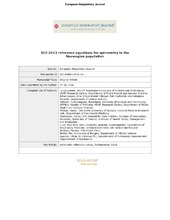Global Lung Function Initiative 2012 reference equations for spirometry in the Norwegian Population
Langhammer, Arnulf; Johannessen, Ane; Holmen, Turid Lingaas; Melbye, Hasse; Stanojevic, Sanja; Lund, May Brit; Melsom, Morten Nissen; Bakke, Per S.; Quanjer, Philip
Peer reviewed, Journal article
Accepted version
Permanent lenke
https://hdl.handle.net/1956/15287Utgivelsesdato
2016Metadata
Vis full innførselSamlinger
Originalversjon
https://doi.org/10.1183/13993003.00443-2016Sammendrag
We studied the fit of the Global Lung Function Initiative (GLI) all-age reference values to Norwegians, compared them with currently used references (European Community for Steel and Coal (ECSC) and Zapletal) and estimated the prevalence of obstructive lung disease. Spirometry data collected in 30 239 subjects (51.7% females) aged 12–90 years in three population-based studies were converted to z-scores. We studied healthy non-smokers comprising 2438 adults (57.4% females) aged 20–90 years and 8725 (47.7% female) adolescents aged 12–19 years. The GLI-2012 prediction equations fitted the Norwegian data satisfactorily. Median±sd z-scores were respectively 0.02±1.03, 0.01±1.04 and −0.04±0.91 for forced expiratory volume in 1 s (FEV1), forced vital capacity (FVC) and FEV1/FVC in males, and −0.01±1.02, 0.07±0.97 and −0.21±0.82 in females. The ECSC and Zapletal references significantly underestimated FEV1 and FVC. Stricter criteria of obstruction (FEV1/FVC <GLI-2012 lower limit of normal (LLN)) carried a substantially higher risk of obstructive characteristics than FEV1/FVC <0.7 and >GLI-2012 LLN. Corresponding comparison regarding myocardial infarction showed a four-fold higher risk for women. The GLI-2012 reference values fit the Norwegian data satisfactorily and are recommended for use in Norway. Correspondingly, the FEV1/FVC GLI-2012 LLN identifies higher risk of obstructive characteristics than FEV1/FVC <0.7.
